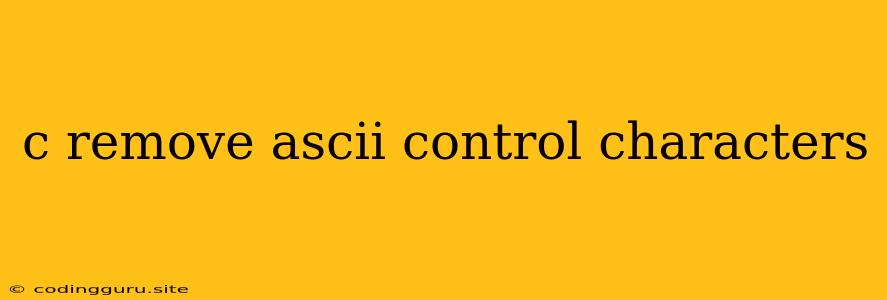How to Remove ASCII Control Characters in C
ASCII control characters are non-printable characters that are used to control devices or data transmission. They are often represented by the ASCII codes 0-31 and 127. While they are not visible, they can cause problems in your C programs, such as unexpected behavior or corrupting data. Therefore, it is important to remove these characters from your data before processing it.
Why Remove ASCII Control Characters?
Here are some of the reasons why you should remove ASCII control characters:
- Data Corruption: Control characters can interfere with data processing, leading to incorrect output or corrupted files. For example, a control character in a text file might be interpreted as a command, causing unintended behavior.
- Unexpected Behavior: Control characters can disrupt the flow of data and cause unexpected program behavior. For example, a control character in a string might be interpreted as a newline, leading to unexpected line breaks.
- Security Concerns: In some cases, control characters can be used to inject malicious code or exploit vulnerabilities in applications. It is crucial to remove these characters from user input to prevent such attacks.
Methods for Removing ASCII Control Characters
There are a few different methods you can use to remove ASCII control characters from your C program. Here are some of the most common:
1. Using iscntrl() function:
The iscntrl() function is part of the standard C library (ctype.h). It checks whether a given character is a control character. You can use it in a loop to iterate through the characters in your string and remove any control characters.
Example:
#include
#include
#include
int main() {
char str[] = "This is a string with\x08control characters.";
char cleanStr[100];
int i, j = 0;
for (i = 0; i < strlen(str); i++) {
if (!iscntrl(str[i])) {
cleanStr[j++] = str[i];
}
}
cleanStr[j] = '\0';
printf("Original string: %s\n", str);
printf("Cleaned string: %s\n", cleanStr);
return 0;
}
2. Using strcspn() function:
The strcspn() function calculates the length of the initial segment of a string that does not contain any character from a given set of characters. You can use it to find the position of the first control character in your string and then remove it.
Example:
#include
#include
int main() {
char str[] = "This is a string with\x08control characters.";
char controlChars[] = "\x00\x01\x02\x03\x04\x05\x06\x07\x08\x09\x0A\x0B\x0C\x0D\x0E\x0F\x10\x11\x12\x13\x14\x15\x16\x17\x18\x19\x1A\x1B\x1C\x1D\x1E\x1F";
char cleanStr[100];
int i, j, pos;
for (i = 0; i < strlen(str); i++) {
pos = strcspn(str + i, controlChars);
if (pos == 0) {
i++; // Skip the control character
} else {
strncpy(cleanStr + j, str + i, pos);
j += pos;
i += pos;
}
}
cleanStr[j] = '\0';
printf("Original string: %s\n", str);
printf("Cleaned string: %s\n", cleanStr);
return 0;
}
3. Using regex (Regular Expressions):
Regular expressions provide a powerful way to match and manipulate text patterns. You can use a regular expression to match all control characters and replace them with an empty string.
Example:
#include
#include
#include
int main() {
char str[] = "This is a string with\x08control characters.";
char *cleanStr;
regex_t regex;
regmatch_t match;
int ret;
ret = regcomp(®ex, "[\\x00-\\x1F\\x7F]", REG_EXTENDED);
if (ret != 0) {
fprintf(stderr, "Error compiling regex\n");
return 1;
}
cleanStr = strdup(str);
if (regexec(®ex, cleanStr, 1, &match, 0) == 0) {
cleanStr[match.rm_so] = '\0';
}
regfree(®ex);
printf("Original string: %s\n", str);
printf("Cleaned string: %s\n", cleanStr);
free(cleanStr);
return 0;
}
Tips for Removing ASCII Control Characters
Here are some additional tips for removing control characters from your C programs:
- Validate User Input: Always sanitize user input by removing control characters and other potentially harmful characters. This helps to prevent injection attacks and ensure data integrity.
- Consider Context: When removing control characters, it's essential to consider the context of the data. Some control characters might be valid in specific data formats, such as escape sequences in JSON strings.
- Use Libraries: If you need more advanced functionality, consider using libraries specifically designed for string manipulation and data sanitization. These libraries can handle complex cases and provide optimized performance.
Conclusion
Removing ASCII control characters from your C programs is essential for ensuring data integrity, preventing unexpected behavior, and mitigating security risks. By using the methods and tips outlined in this article, you can effectively eliminate these non-printable characters from your data and ensure your programs run smoothly and securely.
